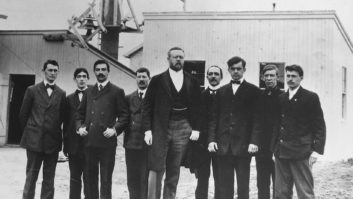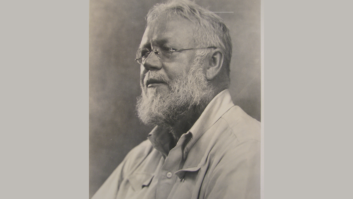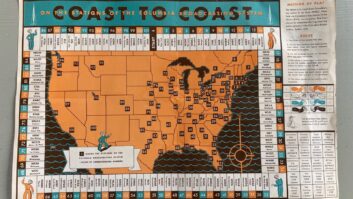Let us continue our story of the history of wire, which we began in September and discussed recently in the May 7 issue.
Into our story comes a figure, a simple man with a simple idea. He worked for a company named Kellogg. Not the cereal people; this company supplied wire and cable to Western Electric, vendor to the Bell System.
At the turn of the century, the popular wire was covered with silk. If you looked inside an operator’s switchboard in 1900, it was filled with silk-covered wire.
Our subject purchased such wire. But he became dissatisfied with the quality he was offered so he left Kellogg and started a wire manufacturing plant in Chicago. His name was Joseph C. Belden (1876-1939).
The plant made superior cloth and silk-covered wire. One of his employees had a breakthrough in 1906, flexible enamel. Now they could coat a wire with a thin layer of non-conductor. And when it was coiled into an inductor or transformer, the enamel wouldn’t chip or flake off, as regular enamel would, shorting out the device.
What perfect timing. The vacuum tube amplifier, the “audion,” was born the same year.
Down the wire
By the turn of the 20th century, long-distance phone service was a major problem. To send a telephone signal down long wires, high voltages were required simply to overcome the resistance of the wire. That meant that, at the starting end, lethal voltages had to be run through carbon microphones, endangering operators.
Further, the voltages slowly destroyed the carbon microphones as they were used. A way to increase the signal strength was needed.
This had been done easily in the telegraph world by the use of a relay, where a small voltage could control a switch handling a larger voltage. Now something similar was called for, but it would have to be a “variable switch,” something we know today as amplification.
Lee de Forest (1873-1961) patented his audion vacuum tube, which had a gain of 5-10, in 1906. But here, boys and girls, I must tread lightly, because the issue of who invented amplification remains controversial.
In later court documents, de Forest couldn’t adequately explain how the audion worked. On Oct. 30, 1912, Harold D. Arnold, working for what would become the Bell System, was given a demonstration of the audion. He recognized the potential of the tube to amplify telephone signals. Arnold built his first amplifying vacuum tube Oct. 18, 1913, with an improved “vacuum.” These were installed as telephone amplifiers for long-line transmission.
But the actual “triode amplifier” was credited to Major Edwin H. Armstrong (1890-1954). In 1912, while still a student at Princeton, he made improvements to the audion. The main one was to send the slightly amplified signal back into the grid, thus re-amplifying the signal. This “feedback” arrangement was instantly successful and gave an amplification factor of 10,000 or more.
Armstrong and his fellow students could listen to telegraph signals without even putting on headphones. And when he increased the feedback, he could get the tube to oscillate, the basis for all future broadcast transmission.
By 1916, all sorts of people were into broadcasting, including Armstrong and de Forest. In fact, the Federal Department of Commerce, then in charge of “experimental” radio, shut down de Forest’s experimental station because it was playing music. The letter sent to him explained, in no uncertain terms, “There is no room in the ether for entertainment.”
There is another figure who was “playing with radio” that same year. He single-handedly changed the landscape of broadcasting and of American culture. And he was responsible for the purchase and installation of a lot of wire and cable. See if you can guess who he is.
No rabbi he
He was born in Russia in 1891. His parents send him to rabbinical school. It is probably lucky that he never pursued this career, as he would probably have made the worst rabbi ever.
To avoid the pogroms, the family moved to the United States in 1900. Here the young boy learned English and became entranced by the telegraph. In his late teens, he got a job as a telegraph operator working for the Marconi Wireless Telegraph Company atop the Wanamaker Hardware building in New York City.
There, on April 14, 1912, at age 21, he was operator on duty when a call came in. This was no normal call, but an S-O-S from a ship at sea. (The use of S-O-S for emergencies had only been established a few months before.)
The ship was the Titanic. As news hit the streets, this young man’s name instantly became a household word. And for the last time in history, radio silence was declared all along the East Coast so that this man could receive and send messages to the Titanic and the ships going to its aid.
The story has been carefully crafted into legend, so it is not known for sure if he was the first person to hear of the disaster. However, it is accepted that he stayed at his post for 72 hours, relaying messages to and from the ships going to rescue the survivors.
By 1916, along with Armstrong and de Forest, he was using his newfound fame to push the idea of commercial radio, something he called the “wireless music box,” although this idea was before its time. Even as late as 1920, one potential investor wrote him to say, “The wireless music box has no imaginable commercial value. Who would pay for a message sent to nobody in particular?”
Even the Marconi Company, his employer, rejected the idea of radio as anything but a communications medium. So he went to work for the Radio Corporation of America in 1920.
By 1921, RCA’s broadcast of the Dempsey-Carpentier boxing match attracted 300,000 radio listeners. Radio was off and running.
Our hero eventually rose to chairman of the board from 1947-1970. His exploits regarding the founding of NBC, his ruthless business dealings, especially with inventors such as Philo T. Farnsworth and C. Francis Jenkins, are detailed elsewhere.
His name? David Sarnoff (1891-1971). He liked the honorary title of “General.”
RCA pretty much owned the broadcast industry and, therefore, was responsible for a lot of wire and cable.
Stay tuned. Next time we will visit the formation of Bell Labs, and boy, do things take off from there.










